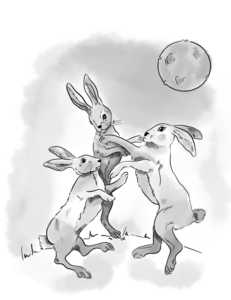Spring Equinox Book Launch for ‘Hare Today Gone Tomorrow’
What a day we all had on Sunday 20th March 2022 for the dual celebration of the spring equinox and the launch of my new book Hare today Gone tomorrow.
The day was amazing and the perfect start to national tree week. It was great to see so many of you and plant trees and litter pick with everyone, we all did a good deed for the environment.
Thank you to Kildare County Council for supplying us with 300 trees.

About the Spring Equinox
So, what happens during the spring equinox? In simple terms, the spring equinox is when the Sun crosses the celestial equator (an imaginary line in the sky above Earth’s equator), going from the southern hemisphere to the northern hemisphere. As the Sun is exactly above the equator, both the northern hemisphere and the southern hemisphere receive nearly equal amounts of the Sun’s rays. In other words, the day and night are (almost) equal in both hemispheres.
The word ‘equinox’ derives from the Latin aequi, meaning ‘equal’, and nox, meaning ‘night’, so together, translates as ‘equal night’.
In reality, we will actually be seeing a few more minutes of sunlight at the spring equinox. This is thanks to refraction in the atmosphere that bends the Sun’s rays, causing the Sun to appear above the horizon when it’s actually below, resulting in slightly more daylight than darkness. The March equinox denotes the start of spring in the northern hemisphere, and the start of autumn in the southern hemisphere.
The difference between a solstice and equinox comes down to length. At the two equinoxes, the days and nights are almost of equal length, whereas the solstices mark the shortest (winter solstice) and longest (summer solstice) days of the year.
During the equinoxes, the Sun is directly above Earth’s equator. During the summer solstice, the northern hemisphere is at its maximum tilt towards the Sun, so the Sun appears at its highest, giving us the longest day of the year. During the winter solstice, the northern hemisphere reaches its maximum tilt away from the Sun, so the Sun appears at its lowest in the sky, giving us the shortest day of the year.
The spring equinox sometimes falls on different dates because the Earth takes a little over 365 days to complete a single orbit around the Sun. To be precise, it actually takes 365.25 days for us to orbit around our star. In the Gregorian calendar, they accounted for this by adding one extra day every four years, and this is why we have leap years.
This means that the March equinox occurs with approximately a six-hour difference from the previous year.
About the Book
The second chapter book for Johnny Magory’s little sister, Lily-May. Young Lily-May has always been fascinated by hares, they’re her favourite native Irish animal. But it’s not just their behaviour and looks she likes; she loves the stories her grandad tells her about the hares being shapeshifters. Tales of how the Celtic warrior Oísin injured a hare whilst hunting and followed it only to find a beautiful woman and many more like it.
A determined Lily-May forms a plan, going through their secret tunnel into the magical wild alone, without Johnny or Ruairi. She is going to find out the truth about the hares once and for all. But has her curiosity put her in grave danger?
Suitable for 8 – 12 year olds.
Check out Lily-May’s first adventure, Foul Faeries, here


